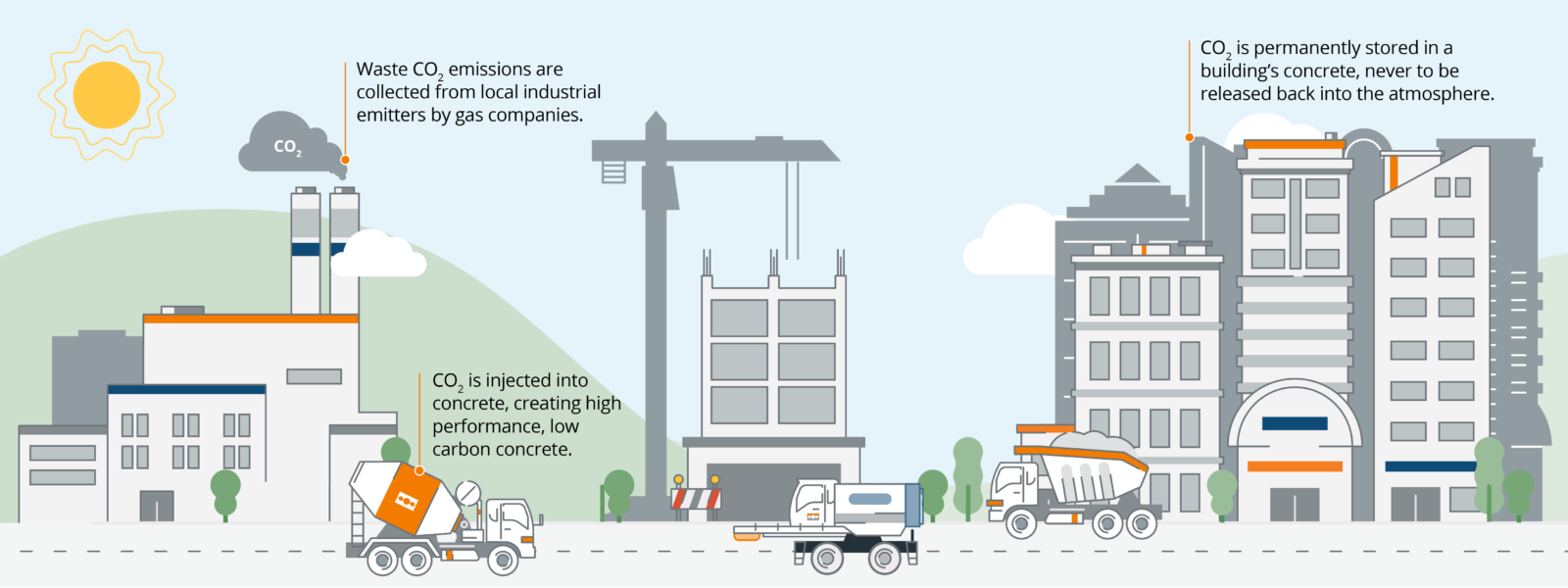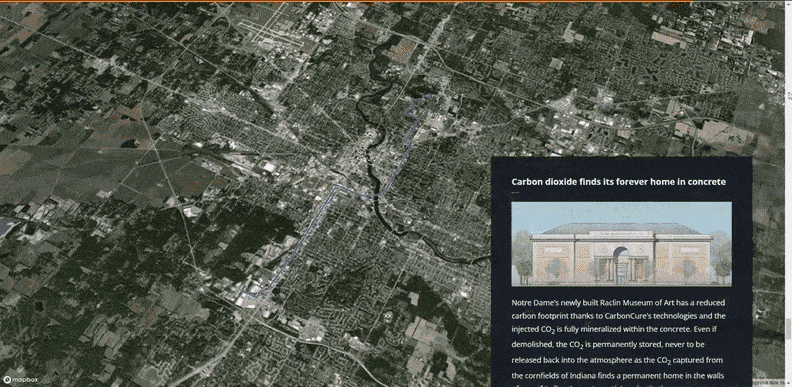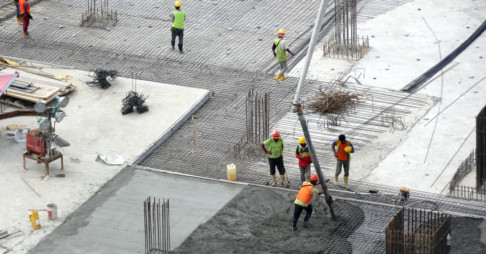CarbonCure Illustrates Localized Nature of its Carbon Removal Pathway with Mapbox Project
Most people are familiar with traceability when it comes to food. Consumers can scan the QR code on their tuna can and find out what ocean the tuna came from and the fisherman who caught it. They can scan their coffee packaging to discover the farm where the beans grew and even the worker who picked them.
Just as consumers can trace the origin of their food, buyers of CarbonCure carbon credits can trace the carbon removal they funded, tracking the carbon dioxide (CO2) from the point of capture to its permanent storage in concrete.
Why Is Traceability of Carbon Credits Important?
Traceability is particularly important for carbon credits because, unlike food or other physical products, carbon credits are less tangible. They represent a colorless, odorless gas—or, more specifically, the absence of it, which historically has been difficult to measure. This has led to various problems, leaving buyers feeling less-than-confident about their purchases in the voluntary carbon market. But it doesn’t have to be that way. Some carbon removal and storage pathways—like CarbonCure’s—are both highly measurable and fully traceable.
Understanding CarbonCure’s Carbon Removal Pathway
CarbonCure Technologies is a carbon dioxide removal tech company on a mission to annually reduce and remove 500 million metric tons of carbon emissions by 2030. Our suite of technologies permanently store captured CO₂ in concrete through carbon mineralization.
Captured CO2 is transported to concrete plants and, using our technology, injected into concrete as its being mixed, and/or into concrete wastewater and end-of-life (recycled) concrete. The CO2 reacts with the cement, turning into a mineral that maintains strength in concrete and enables waste products to be reused in new mixes. The strength provided by the new mineral enables a reduction in cement, which further reduces the carbon footprint of concrete. The mineralized CO2 is locked—for millennia—within the concrete used for buildings and infrastructure. Even if the concrete is destroyed, the CO2 won’t be released back into the atmosphere.

Traceability: The Magic Is in the Metadata
When it comes to tracing CarbonCure carbon credits, the magic is in the metadata.
“For every carbon credit we generate, we have metadata showing the CO2 source, a timestamp of when and where it was mineralized, the projects and locations of the concrete where the carbon is stored—whether in a building, sidewalk or other structure,” says Rahul Misra, Director of Carbon Finance Operations at CarbonCure Technologies. “We also account for the emissions and energy use in transporting the CO2 from its source to the concrete plant, and for operating our technology.”
This granularity in the collection of metadata is why CarbonCure leads the industry in measurement, reporting and verification (MRV) of carbon credits.
M = Measurement
The degree to which the CO2 removal can be accurately quantified and measured.
R = Reporting
The ability to reliably provide accessible CO2 measurement data and information in a usable format.
V = Verification
The independent scientific validation of the CO2 removal methodology and project—and the ability for independent third parties to audit the ongoing CO2 removal and reduction data for accuracy and completeness.
“You know exactly how much CO2 is being injected into each amount of concrete,” says Mitchel Shelby, Sustainability Fund Program Manager for Shopify, a leading global commerce company that purchases CarbonCure carbon credits. “That's a huge leg up for CarbonCure’s solution over other solutions, which have a much more difficult time with MRV.”
Our high-quality MRV gives carbon credit buyers confidence that the carbon credits they purchased are real. And, now, we’re bringing that journey to life with a digital mapping tool.
Visualizing CarbonCure’s End-to-End Carbon Removal Pathway
CarbonCure Technologies has worked with Mapbox and Mapbox trusted developer, Paul Franz, to develop a digital storytelling tool to show How CarbonCure Transforms Concrete Plants into Carbon Removal Facilities. It helps carbon credit buyers visualize the journey of the CO2, mapping the path as it travels from a renewable fuel facility in Indiana to the Ozinga concrete plant, where it is injected into concrete and is permanently stored in the walls of one of Indiana’s most prestigious institutions: Notre Dame’s Raclin Museum of Art.
"It’s one thing to see data on a ledger or in a report, but it’s so much more tangible when you can see the stories behind the data in context. Using an interactive map to tour the local, real-world projects where the carbon removal is happening, and all the stops along the way, helps to make a technical process so much more relatable," says Marena Smith, Manager of Customer Community at Mapbox.
Mapbox, which provides custom online maps for websites and applications, has also made a commitment to climate action, purchasing CarbonCure carbon credits to help zero out their operational CO2 emissions.
The tool they created shows how CarbonCure’s carbon credits not only provide high-quality carbon removal and reduction, but also provide environmental and social co-benefits to host communities, reducing concrete waste, saving water, and creating and sustaining jobs.
This is just one example of what has been accomplished through $3 million in incentives distributed by CarbonCure to concrete producers so far.

The Opportunity and Potential for Positive Impact
So far, more than 650 CarbonCure systems have been sold across the world. But with some 100,000 concrete plants globally, the potential for CarbonCure carbon credits to accelerate the decarbonization of the concrete industry is huge.
“The concrete sector is not going to spend money to retrofit its plants voluntarily…that’s really tough in sectors that have very limited margins,” said Stacy Kauk, Head of Sustainability at Shopify.
Making it financially viable for concrete producers to install CarbonCure technology is a key. “It really was the first time I understood what the revenue from a carbon credit could achieve,” said Stacy.
And at the end of the day, that’s exactly what carbon buyers want and need: to have that achievement of CO2 removal and reduction trace directly back to their purchase of carbon credits.
Learn More
Check out the Mapbox project to discover How CarbonCure Transforms Concrete Plants into Carbon Removal Facilities.

How SBTi’s New Standards Could Unlock Corporate Climate Potential

